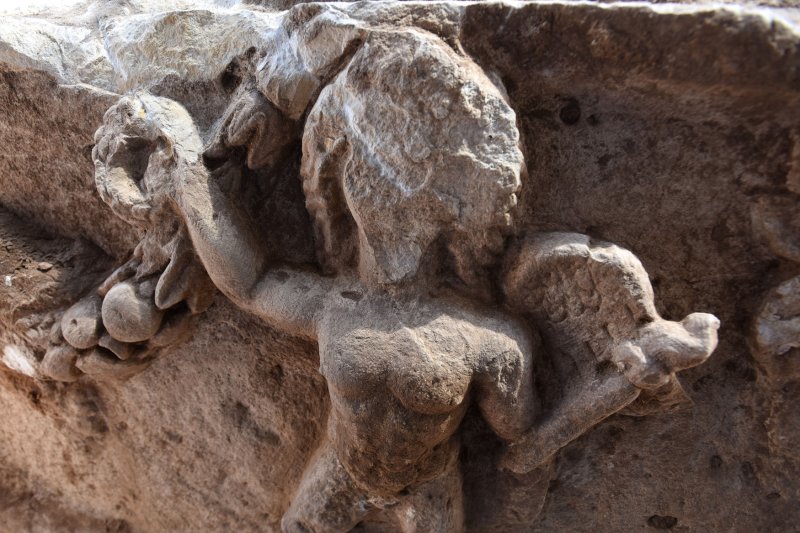1 of 13 | A naked cupid adorns the side of a unique Roman-era sarcophagus at the Israeli Antiquities Authority's National Treasures warehouse in Beit Shemesh, Israel, September 3, 2015. The sarcophagus is 1,800 years old, weighs two tons, measures 2.5 meters and is made of hard limestone. It was discovered by the Antiquities Authority after it was severely damaged when building contractors improperly removed it from the ground in Ashkelon in the southern Israel. Photo by Debbie Hill/ UPI |
License Photo
ASHKELON, Israel, Sept. 3 (UPI) -- Researchers with the Israel Antiquities Authority (IAA) recently unveiled their latest discovery, a remarkably well-preserved Roman-era sarcophagus.
The 1,800-year-old funeral receptacle is carved from limestone and weighs nearly two tons. A life-size, toga-wearing woman is carved into lid, and the coffin's sides are decorated with Roman patterns and the head of Medusa.
The impressive artifact was discovered by construction workers in Ashkelon, Israel. The contractors tried to hide the coffin out of fear its discovery would stall their construction project. But their scheme was uncovered by inspectors with IAA's Robbery Prevention Unit.
While archeologists are thrilled with the find, officials are dismayed by damage done to the coffin during its handling by construction workers. The IAA is currently pursuing legal action against those involved.
"The right way to conduct city of ancient history and important Ashkelon is transparency, openness and walking Landowners hand in hand with the IAA," Amir Ganor, the director of the IAA's Robbery Prevention Division, said in a press release construction in a city with ancient history, such as Ashkelon, must be conducted with openness and transparency. "Only in this way will be able to develop the city while protecting public assets, for the common good."
In addition to Medusa's head, the sides feature a wine jug, grapes, grape leaves, bulls, cupids and more.
"On one side of the coffin lid carved figure of a man leaning on his left hand," said IAA researcher Gabi Mazor. "He wears a short-sleeved shirt decorated with embroidery on the front, tunic wrapped around his waist. Assigned character's eyes, probably, precious stones disappeared, and hair arranged in curls, a typical Roman hairstyle."
Experts say the coffin likely belonged to a relatively wealthy Roman family, not of Jewish origin.
The finding comes just a few days after the IAA announced the discovery of a mysterious 2,000-year-old podium on an ancient street in the City of David.















